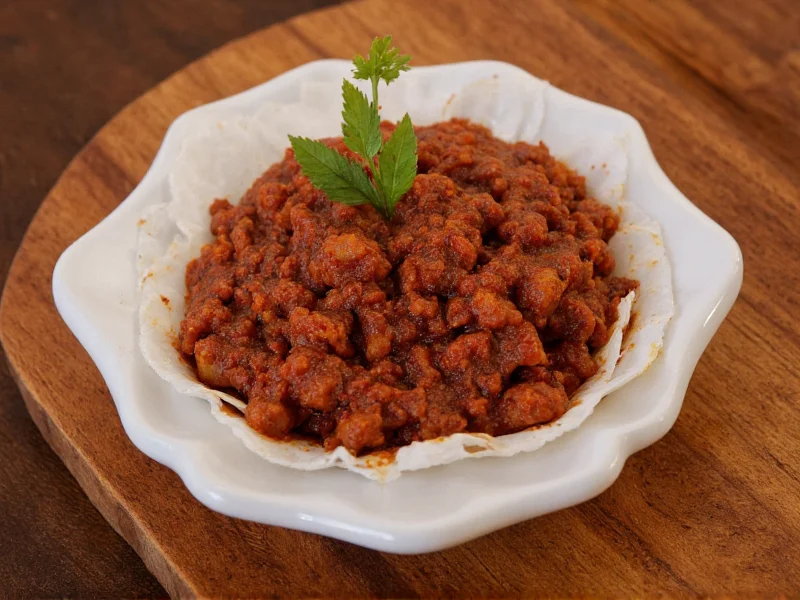When people search for "mole colorado," they're usually seeking information about this unique Southwestern adaptation of traditional Mexican mole rather than the burrowing mammal or skin growth. This regional specialty represents the cultural fusion between Colorado's Hispanic communities and indigenous culinary traditions that have evolved over generations.
Understanding Mole Colorado's Cultural Roots
Mole Colorado isn't an official state dish but rather a regional interpretation of Mexico's complex mole tradition. The term "colorado" (Spanish for "reddish") describes the sauce's characteristic brick-red hue, primarily derived from New Mexico chiles which thrive in Colorado's high-altitude climate. Southern Colorado's culinary landscape, particularly in the San Luis Valley and along the Front Range, shows strong influences from neighboring New Mexico where red chile sauces are fundamental to the cuisine.
Historically, the exchange of culinary traditions between Colorado and New Mexico intensified during the 19th century when Hispanic settlers moved north along the Rio Grande. These communities brought their mole-making techniques but adapted recipes to incorporate locally available ingredients, creating what Coloradans now recognize as their regional mole variation.
Key Ingredients That Define Colorado's Mole
While traditional Oaxacan moles often contain chocolate and numerous spices, Mole Colorado distinguishes itself through:
- Primary use of dried New Mexico red chiles instead of mulato or ancho chiles
- Tomatoes or tomatillos as base ingredients
- Local Colorado-grown garlic and onions
- Regional herbs like oregano from the San Luis Valley
- Occasional addition of Colorado-grown piñon nuts
- Rarely contains chocolate (unlike mole negro)
| Mole Variety | Primary Color | Key Ingredients | Regional Origin |
|---|---|---|---|
| Mole Colorado | Brick red | New Mexico chiles, tomatoes, local spices | Colorado Front Range/San Luis Valley |
| Mole Negro | Dark brown | Chocolate, mulato chiles, complex spices | Oaxaca, Mexico |
| Mole Rojo | Bright red | Guajillo chiles, tomatoes, minimal spices | Central Mexico |
| Colorado Red Chile Sauce | Vibrant red | New Mexico chiles, garlic, cumin | New Mexico |
Where to Experience Authentic Mole Colorado
For those seeking genuine Mole Colorado preparation, several Colorado establishments maintain traditional preparation methods passed through generations:
- Pueblo's Historic Union Avenue: Several family-owned restaurants serve mole dishes reflecting the region's Hispano heritage
- San Luis Valley eateries: In Colorado's oldest continuously inhabited town, local cooks prepare mole using century-old recipes
- Denver's South Federal Boulevard: Numerous Mexican restaurants offer interpretations of Colorado-style red mole
- Seasonal festivals: The Pueblo Chile & Frijoles Festival and other cultural events often feature traditional mole preparation
Preparing Mole Colorado at Home
Creating authentic Mole Colorado requires attention to traditional preparation techniques while accommodating Colorado's unique ingredients. The process typically involves:
- Rehydrating New Mexico chiles in hot water for 20-30 minutes
- Dry-toasting spices like cumin and coriander seeds to enhance flavor
- Blending chiles with roasted tomatoes, garlic, and toasted spices
- Simmering the sauce for several hours to develop complex flavors
- Serving over roasted chicken or turkey with traditional accompaniments
Unlike Oaxacan moles requiring dozens of ingredients, Colorado's version typically uses 8-12 components, reflecting the region's agricultural limitations while maintaining depth of flavor. Many Colorado families incorporate locally grown ingredients like San Luis Valley potatoes or piñon nuts harvested in the Sangre de Cristo mountains.
Common Misconceptions About Mole Colorado
Several misunderstandings persist about this regional specialty:
- It's Colorado's official state dish: Colorado has no official state dish, though green chile is culturally significant
- It contains chocolate: Traditional Mole Colorado rarely includes chocolate, distinguishing it from Oaxacan mole negro
- All red sauces are mole: Many Colorado restaurants serve New Mexican-style red chile sauce, which differs from mole in preparation and ingredients
- It's identical to Mexican mole rojo: Colorado's version incorporates local ingredients and preparation methods that create a distinct flavor profile
Cultural Significance in Colorado Communities
Mole Colorado represents more than just a sauce—it embodies the cultural resilience of Colorado's Hispano communities. In southern Colorado, mole preparation often accompanies significant life events including weddings, quinceañeras, and religious celebrations. The communal aspect of mole-making, where families gather to toast spices and blend ingredients, preserves cultural traditions while adapting to Colorado's unique environment.
Recent culinary scholarship recognizes how Colorado's version maintains authenticity while evolving with local conditions. Food historians note that the adaptation of mole traditions reflects broader patterns of cultural exchange along the Colorado-New Mexico border region, where culinary practices have blended for centuries.
Conclusion
Mole Colorado represents a distinctive culinary adaptation that reflects Colorado's unique cultural landscape. This regional variation maintains the spirit of traditional Mexican mole while incorporating local ingredients and preparation methods that have evolved over generations. Understanding its proper preparation, cultural significance, and distinguishing characteristics helps preserve this important aspect of Colorado's culinary heritage while avoiding common misconceptions about this vibrant red sauce.











 浙公网安备
33010002000092号
浙公网安备
33010002000092号 浙B2-20120091-4
浙B2-20120091-4